Rachel Dodge's Blog, page 7
April 14, 2022
Imagining Jane Austen’s Childhood Garden

When visiting Jane Austen’s England today, you can stroll through the gardens at Chawton House and Jane Austen’s House Museum, explore the churches at Steventon and Chawton, and tour the homes and churches where Jane Austen and her relatives lived and worshipped in Bath and other areas of England. But what about Steventon Rectory (or parsonage) where Jane Austen and her family lived for the first 25 years of her life?
At Steventon, you can see the site of the rectory and get an idea of where it used to sit before it was torn down in the 1820s. It’s a beautiful spot in the lovely Hampshire countryside. And there’s more to see than just the fields and lanes where Austen grew up.
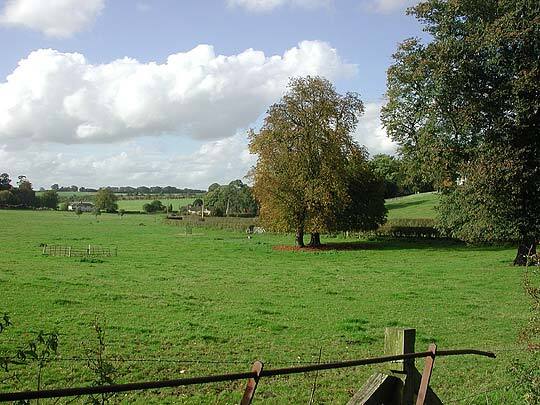 The old rectory site where the parsonage once stood. A well is the only visible remnant of that house.
The old rectory site where the parsonage once stood. A well is the only visible remnant of that house.If you drive up the tree-canopied lane further, you come to St. Nicholas Church, where Jane’s father preached and where Jane and her family attended church. The church is usually open for visitors who want to look or sit or reflect.
 Road to St. Nicholas Church, Steventon. Photo @ Rachel Dodge.The Rectory Landscape
Road to St. Nicholas Church, Steventon. Photo @ Rachel Dodge.The Rectory LandscapeThough we can’t take a tour of the gardens and property surrounding the Rectory, we do have detailed descriptions available to help us imagine what it once was like.
Deirdre Le Faye paints a descriptive picture of the Rectory garden in Jane Austen: The World of Her Novels: “Mr. Austen’s study was at the back of the house, on the warm southern side, overlooking the walled garden with its sundial, espaliered fruit trees, vegetable and flower beds and grassy walks.” Green meadows stretched beyond it, dotted with livestock.
In A Memoir of Jane Austen, James Edward Austen-Leigh provides this further description of the landscape surrounding the Rectory:
“[T]he neighbourhood had its beauties of rustic lanes and hidden nooks; and Steventon, from the fall of the ground and the abundance of its timber, was one of the prettiest spots in it… It stood ‘in a shallow valley, surrounded by sloping meadows, well sprinkled with elm-trees, at the end of a small village of cottages, each well provided with a garden, scattered about prettily on either side of the road…”
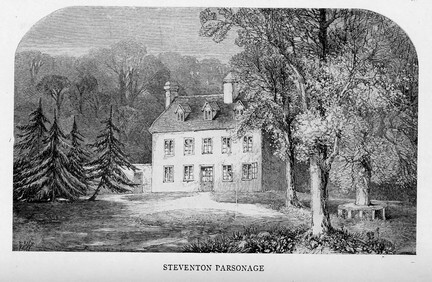 Parsonage, Steventon
Parsonage, SteventonAusten-Leigh continues with this: “North of the house, the road from Deane to Popham Lane ran at a sufficient distance from the front to allow a carriage drive, through turf and trees. On the south side, the ground rose gently and was occupied by one of those old-fashioned gardens in which vegetables and flowers are combined, flanked and protected on the east by one of the thatched mud walls common in that country, and overshadowed by fine elms. Along the upper or southern side of the garden ran a terrace of the finest turf…”
ImprovementsIn Jane Austen’s England, Maggie Lane provides several details about the changes the Austens made during their residency there. She says one of the “constant themes of discussion at Steventon Rectory was ‘improvement.’ Much had been done even before Jane’s birth, but throughout her twenty-five years’ residence there her parents were enthusiastically planting and landscaping their modest grounds.”
The following are some of the grander changes the Austens made to the landscape:
They planted a “screen” of chestnuts and spruce fir to “shut out the view of the farm building.”They cut “an imposing carriage ‘sweep’ through the turf to the front door.”The Church Walk – a “broad hedgerow of mixed timber and shrub, carpeted by wild flowers and wide enough to contain within it a winding footpath for the greater shelter and privacy of the family in their frequent walks to the church.”The Elm Walk (or Wood Walk) – a similar hedgerow walk that skirted the meadows and included the “occasional rustic seat” where “weary stollers” could sit or rest.In Austen-Leigh’s Memoir, he provides further details about the walks and hedgerows:
“But the chief beauty of Steventon consisted in its hedgerows. A hedgerow in that country does not mean a thin formal line of quickset, but an irregular border of copse-wood and timber, often wide enough to contain within it a winding footpath, or a rough cart-track. Under its shelter the earliest primroses, anemones, and wild hyacinths were to be found; sometimes the first bird’s nest; and, now and then, the unwelcome adder. Two such hedgerows radiated, as it were, from the parsonage garden. One, a continuation of the turf terrace, proceeded westward, forming the southern boundary of the home meadows; and was formed into a rustic shrubbery, with occasional seats, entitled ‘The Wood Walk.’ The other ran straight up the hill, under the name of ‘The Church Walk,’ because it led to the parish church…”
 Hampshire is still breathtaking; scenes like these give us a sense of the greenery and vegetation Austen might have known.
Hampshire is still breathtaking; scenes like these give us a sense of the greenery and vegetation Austen might have known.In October 1800, Jane wrote to Cassandra about the improvements her parents were undertaking at the time: “Our improvements have advanced very well; the bank along the elm wall is sloped down for the reception of thorns and lilacs, and it is settled that the other side of the path is to continue turfed, and to be planted with beech, ash, and larch.”
In November, she wrote again: “Hacker has been here to-day putting in the fruit trees. A new plan has been suggested concerning the plantation of the new inclosure (sic) of the right-hand side of the elm walk: the doubt is whether it would be better to make a little orchard of it by planting apples, pears, and cherries, or whether it should be larch, mountain ash, and acacia.”
Reading these descriptions, it’s easy to see why Jane Austen included “improvements” to the grounds of the estates featured in so many of her novels.
Food and LivestockHowever, the Austens didn’t just improve their land to make it more pleasing to the eye or pleasurable for walking. Lane tells us that “the garden at Steventon Rectory was a happy compromise between fashionable ideas and down-to-earth utility – typical of the balanced Austen approach to life.”
In Mrs. Austen’s garden, “vegetables and flowers [were] combined” to balance beauty and provision. One can imagine how the garden must have looked in the spring, summer, and fall, with its tangled profusion of color.
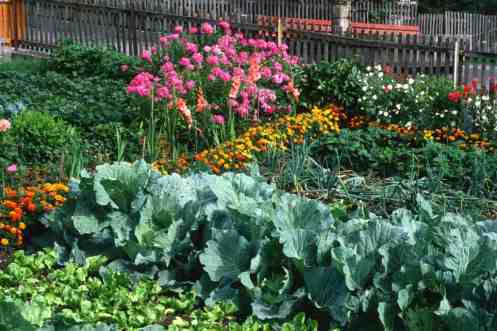 Today, “companion planting” is popular for many gardeners who include flowers among their vegetables.
Today, “companion planting” is popular for many gardeners who include flowers among their vegetables.Beyond the gardens around the Rectory, the Austens kept livestock and grew crops. Mrs. Austen oversaw the poultry-yard and the dairy: “She supervised making all the butter and cheese, baking all the bread and brewing all the beer and wine required by a large household. With the exception of such commodities as tea, coffee, chocolate and sugar, the Austens were virtually self-sufficient in food.” As for Rev. Austen, he grew “oats, barley and wheat, and reared cattle, pigs and sheep” and was able to “not only feed his family, but to sell the surplus.” (Lane)
“All the fruit, vegetables, and herbs consumed by the family were raised here. The Austens’ strawberry fields were famous, and Mrs. Austen was one of the first people in the neighbourhood to grow potatoes.” Taking this all into account, we get a better idea of the gardens and food Jane Austen enjoyed in her youth.
 Today, strawberry crops are still grown and produced in Hampshire.
Today, strawberry crops are still grown and produced in Hampshire.Reading these descriptions of the land surrounding Steventon Rectory can help us better envision what the gardens and fields looked like when Austen was growing up. It’s lovely to try to imagine where she walked and read and thought and imagined; what foods she ate; and what her parents did.
If there ever was a fundraising campaign I could get behind, it would be to someday see a replica (or a scale model) built of the Steventon Rectory and its surrounding gardens. Wouldn’t that be something? For now, I’ll keep dreaming and imagining, which almost just as nice.
If you’d like to take a deeper dive into the Steventon Rectory and its garden and farm, you can read “Why Was Jane Austen Sent away to School at Seven? An Empirical Look at a Vexing Question” in Persuasions On-Line by Linda Robinson Walker.
The post Imagining Jane Austen’s Childhood Garden appeared first on Rachel Dodge.
April 7, 2022
The Anne Devo: ECPA Christian Book Award Finalist!
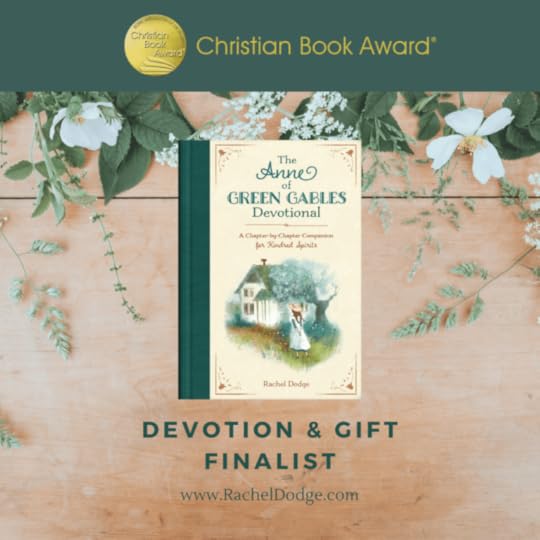
Somebody, please pinch me!!
I just got news today that the ECPA has selected The Anne of Green Gables Devotional as a finalist for the 2022 Christian Book Award in the Devotion & Gift Category!
I don’t know whether to squeal or cry, so I’m gonna go ahead and do both! Will you join me?
It was an absolute dream to write this book and it’s an incredible honor to be nominated, let alone be a finalist, for this award. Thank you to Barbour Books for the opportunity to write this incredible book. Thank you to every friend and reader who has supported this book and helped share its message of adoption and belonging in Christ!
My heart’s cry for this book has been and will always be that every reader who picks it up would fully grasp the deep love of the Father for his precious adopted daughters in Christ!
Much love to you all, Kindred Spirits!!
Grace and peace,
Rachel
The post The Anne Devo: ECPA Christian Book Award Finalist! appeared first on Rachel Dodge.
March 23, 2022
Guest Post: Daisy F. Dronen on Marmee and Motherhood
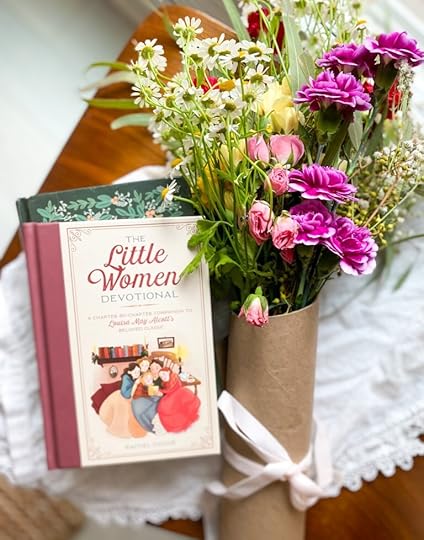
The following are excerpts from Daisy F. Dronen’s Wednesday Words, where she shares the impact Marmee March has had on her parenting and her tender experiences reading Little Women alongside The Little Women Devotional with her children. Here’s Daisy:
I love reading. I have loved reading from the minute I learned to string words together. I am not sure why I had never read Little Women, but I am so glad I discovered it along side my kiddos! I will forever treasure reading this book together.
We reread it this winter and I am so glad that I had Rachel’s new Little Women Devotional. This chapter by chapter companion truly spurred me to begin again as Marmee invites her girls to do. To begin again in a more gentle and slow way for all things. In parenting, to extend grace more earnestly when I just want compliance. In life, to wait with patience when I just want things to get done. In relationships, to wade deeper into uncertain pools as we love each other when I just want comfort and ease.
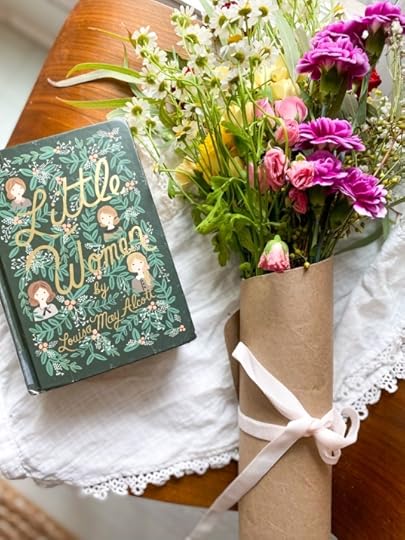
The beautiful devotions drew out of the chapter a still small voice that invited me to reflect and learn instead of only being entertained. The sweet illustrations added a whimsical feel and helped me imagine myself in the scene. I loved showing the pictures to the kiddos and they made sure I didn’t forget. The prayer that Rachel offers at the end of each devotional without fail touched on a need or a struggle we were facing that day.
I may or may not have cried as I read the devotionals. The last one was so sweet and encouraged me so much in motherhood. The kiddos all came around and hugged me when my voice cracked reading about the fruit of Marmee’s investment in her children. I believe reading this devotional together with my children not only strengthened our bond but also gave us more insight into how we can love each other better. Read more of Daisy’s lovely story HERE.
Meet DaisyDaisy F. Dronen is a writer, blogger, and encourager. She describes herself as a bellwether table-gatherer who loves fresh cut flowers and reading-always reading! She invites women to join her around the table creating a beautiful space in which to have heart conversations. She believes the invitation to come around the table nurtures the deepest parts of who we are and allows for us to then invite others in. You can follow her on on IG @daisyfd or at DaisyDronen.food.blog.
The post Guest Post: Daisy F. Dronen on Marmee and Motherhood appeared first on Rachel Dodge.
March 19, 2022
Finding Comfort in Jane Austen

When the world is topsy-turvy and our hearts are heavy, many of us find comfort in books. And there’s something special in particular about the beauty of Austen’s novels, in the richness of the movie adaptations, and even in the thought of the lovely Hampshire countryside, secluded and beautiful, tucked away and secure.
The world inside Austen’s novels never changes. The familiar scenes and characters are always there and waiting. Elizabeth and Darcy never fail to spar and flirt in the drawing room in Pride and Prejudice. Mr. Woodhouse continues to eat his porridge and worry comfortably over the weather in Emma. And at the end of Persuasion, Captain Wentworth always sits down to write his letter to Anne Elliot.
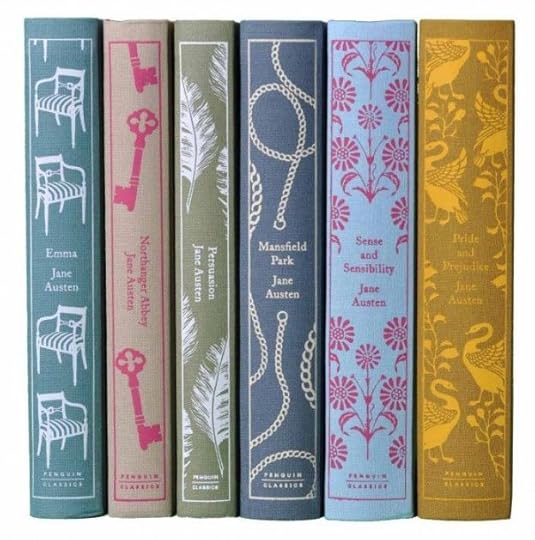
Perhaps that’s why many of us (and why so many others throughout history) have found solace and comfort within the pages of Austen’s novels, especially during times of turmoil. And why her novels have been reprinted and translated and enjoyed around the world by so many people for over 200 years.
Familiar FacesI find similar comfort in the film adaptations. When I sit down to watch a Jane Austen movie (or even have one playing in the background as I do chores), I love knowing just what to expect. I can’t wait to hear the music I love, listen to the accents and voices of characters and actors I adore, and watch the ever-amusing (and always touching) storylines unfold.
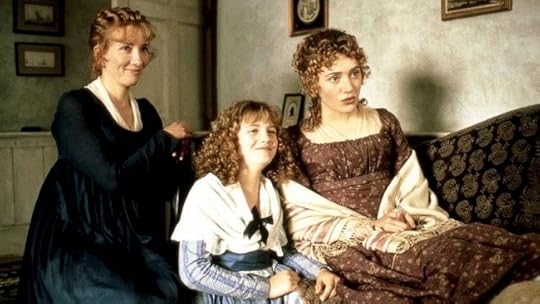 Sense and Sensibility, 1995.
Sense and Sensibility, 1995.
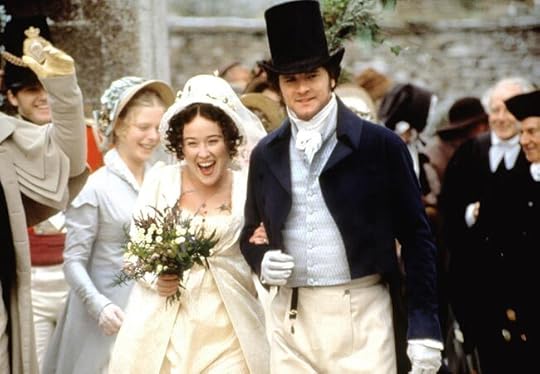 Pride and Prejudice, 1995.
Pride and Prejudice, 1995.
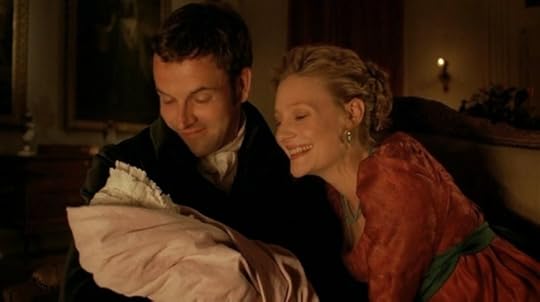 Emma, 2009.
Emma, 2009.The comfort and familiarity of Austen movies keeps us coming back for more, year after year. There are always new adaptations to enjoy and critique (because there’s nothing better than debating this Emma over that Emma with Austen friends).
Familiar SightsAnd then there’s the comfort of Jane Austen’s actual world. Although I know Hampshire is a real place with its own fair share of regular, everyday life activities and stormy days, both figurative and literal (such as when Storm Eunice brought down many trees on the Chawton estate and in Mingledown Woods just last month), the England described in Austen’s novels never fades.
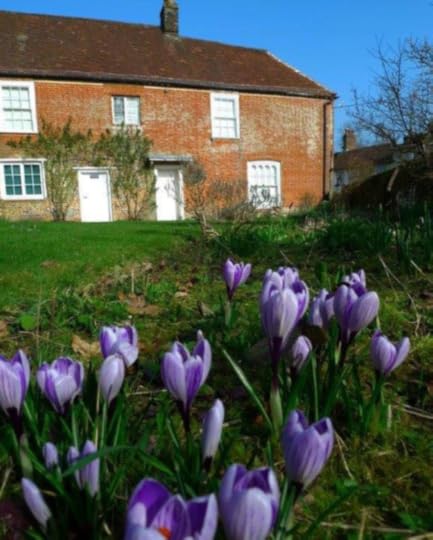 Jane Austen’s House Museum, 2022.
Jane Austen’s House Museum, 2022.I think the charm of the setting in her books is another reason so many of us as lifelong students and fans of Austen love to learn about her life, her family, and the places where she lived and wrote. During the height of the pandemic, we all did what we could to support the historic sites in England and watched for updates whenever possible. We dreamed of the day when we might get to visit those precious sites again or for the first time. Many of us even took virtual tours so we could “be” there.
Benches Along the WayThat’s probably why I was so overjoyed when I saw the good news a few weeks ago that the bench my local JASNA regional group sponsored had been installed in the Chawton House Gardens. In fact, the entire bench project fundraising is now complete! (I know many of you have contributed in various ways to the care and keeping of the historic sites as well.) Here is a snippet of the announcement:
“This month, we are pleased to announce that thanks to the wonderful support of the North American Friends of Chawton House (NAFCH), we have received the final 17 benches donated through the ‘Share a Bench with Jane’ scheme, just in time for our Spring Flowers season.“
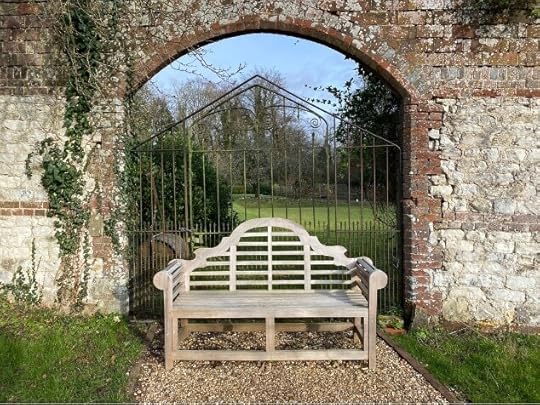 Photo: Chawton House. Bench, 2022.
Photo: Chawton House. Bench, 2022.Location 22: at the head of the Pride and Prejudice Rose Walk.
If you’d like to see all of the bench locations, you can find them HERE.
As I read through the announcement and looked through the photos, I was comforted. I thought about how peaceful it would be to sit on a bench and enjoy the garden around me. I even thought about how I should install a bench in my own small garden area.
And then I came to this lovely quote that was included in the announcement from Chawton House:
“Although the recent storms have caused significant damage to parts of the estate, these latest additions mean that visitors to Chawton House will still be able to rest among the spectacular displays of snowdrops and daffodils as we move into a warmer season.”
Isn’t that an encouraging thought? I made me think. Though storms come in this life, there are benches along the way where we can rest. When the journey is long, it’s important to stop and sit. And though some winter seasons are particularly difficult, spring always comes and bright new flowers always bloom.
Signs of SpringI’ll leave you with that lovely thought and a few photos of the “snowdrops and daffodils” mentioned above. I hope that each of you is finding comfort in the glimpses of beauty around you, in friends and family, in faith and home, in lending a helping hand to others when you can, and in the enjoyment of Jane Austen.
 Photo: Chawton House. Snowdrops, 2022.
Photo: Chawton House. Snowdrops, 2022.
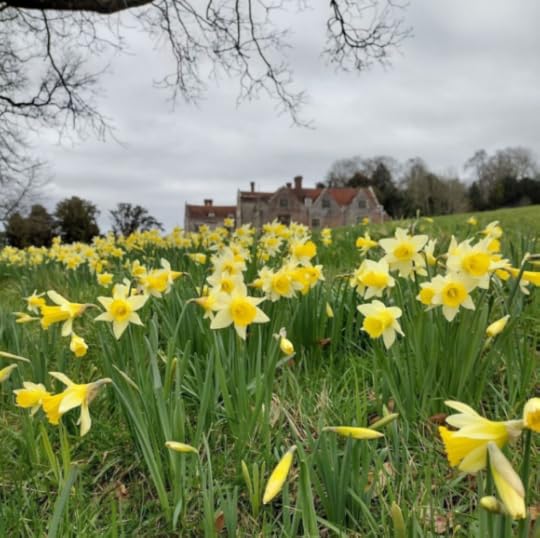 Photo: Chawton House. Daffodils, 2022.
Photo: Chawton House. Daffodils, 2022.
 Photo: Chawton House. Daffodils and Snowdrops, 2022.
Photo: Chawton House. Daffodils and Snowdrops, 2022.Your turn: What is it about Jane Austen’s novels and life that brings you comfort? Why do you think people continue to turn to her work in life’s difficult seasons?
The post Finding Comfort in Jane Austen appeared first on Rachel Dodge.
March 14, 2022
Guest Post: Gracie Carmichael of Austens & Alcotts
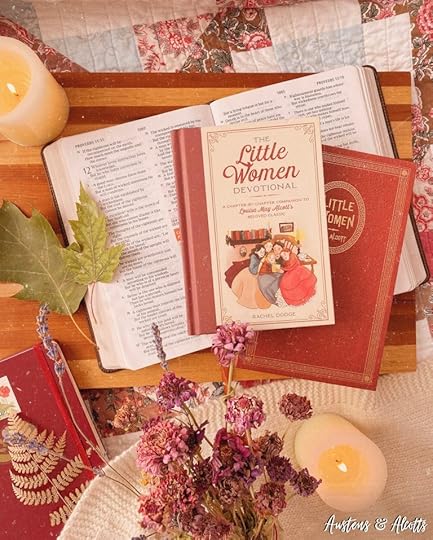
The following are excerpts from a wonderful blog (and Etsy shop) called Austens & Alcotts, a literary site run by artist Gracie Carmichael, that is especially perfect for Kindred Spirits who love classic literature. The article, “Gleaming Jewels of Alcott-ian Wisdom in The Little Women Devotional,” ran earlier this month. Here’s Gracie:
Dear kindred spirit,
I’m delighted you could join me today as we tread upon a new month, full of springtime hopes and heartfelt ideals for a new season of beauty and light ahead of us. The hope of spring to bring us out of winter’s clutches feels directly tied to all my anticipations for the joy to come, perhaps unknown just now, but always happily ahead of us. One of the most hopeful, life-giving joys I’ve been lately blessed with has come in the form of a beautiful, wisdom-filled book which I have the honor of sharing with you today…
The relationships I’ve made through this community of kindred spirits (whether here on the blog or over on “bookstagram”) have been one of the keenest blessings in my life—and a friendship with celebrated bestselling author, Rachel Dodge, has been one to truly touch my heart with her radiant, godly wisdom and admirably unflinching kindness. It was a joy to celebrate the release of her Anne of Green Gables Devotional in late 2020, and I’m thrilled today to be sharing the exciting news of her newest release: The Little Women Devotional: A Chapter-by-Chapter Companion to Louisa May Alcott’s Beloved Classic.

From my very first youthful read of Little Women, its wisdom and timeless worth stood out like gleaming jewels reaped with every chapter, and Rachel has managed to pull out and polish every one of those very jewels from the treasure trove, providing daily devotionals to correspond with every chapter of Alcott’s book, and tying them seamlessly with Scripture. For every daily devotional (one for all 47 chapters of Little Women), the devotionals are followed by a personal application for us to take with us through our day and to cherish in our hearts, which is then beautifully, thoughtfully closed with a correlating prayer.
The story of Meg, Jo, Beth and Amy is one that has truly shaped the arc of my life profoundly, and simply the remembrance of the trials great and small that they faced with the loving, encouraging hand of Marmee to lead them on with wisdom and grace brings with it an incomparable flood of heartwarming comfort to me. And yet, in spite of how well and how dearly I have known and loved them after all this time, there is something new, something added to that comfort with every read. Its wisdom transcends age or familiarity, and it never ceases to teach my heart new ways to walk uprightly, honorably and kindly, keeping faith through the darkest of seasons and finding joy in the honest work which does such good for our weary hearts in times of trial.

The Little Women Devotional touched my heart with those very feelings of heartfelt comfort and hopeful, biblical-centered wisdom three-fold. I was genuinely moved to tears reading through the daily devotionals, and especially the personal applications in which we may apply the timeless lessons which the March girls learned, to our own lives in profound, meaningful ways that affect us, and the people around us, vividly and personally. Alcott’s wisdom absolutely exudes from the pages of Little Women, but Rachel uses this devotional to make that wisdom applicable to our daily lives in ways I’d never thought of for myself—and in doing so, has made the beloved story more precious and valuable to me than ever.
We are none of us exempt from facing the sorrows of this world, and we each of us have our own cross to bear, as did the March sisters. The bigger trials may stand out more clearly to us—from the death of sweet Beth to the period of mourning which Jo faced afterward, or the struggle Jo faces when Laurie confesses his feelings for her. Yet the smaller trials, too, carry much worth with them…
To continue reading Gracie’s article, CLICK HERE.
To shop Gracie’s Austens & Alcotts beautiful Etsy Shop ! Want to follow Gracie on Instagram? You can find her @austensandalcotts for mini blog-posts, a glimpse into her reading life, and giveaways for products from her shop. You can also subscribe to the Austens & Alcotts mailing list to receive Gracie’s twice-monthly newsletter direct to your inbox, where she shares personal encouragement for kindred spirits longing for a simpler, lovelier life, as well as news on shop releases, subscriber-only sales, and more!
The post Guest Post: Gracie Carmichael of Austens & Alcotts appeared first on Rachel Dodge.
February 27, 2022
The Little Women Devotional is Here!
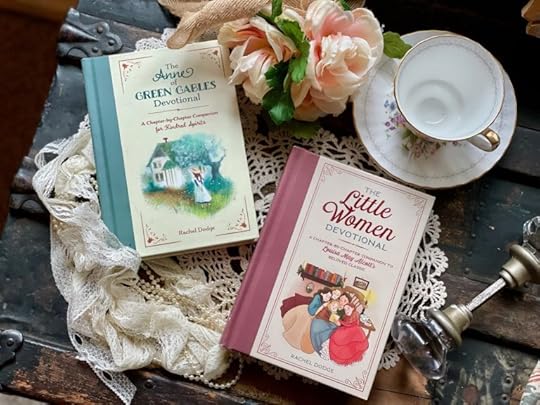
It’s FINALLY time for my Little Women Devotional book launch!!! The book officially releases Tuesday, March 1st. To all who have waited SO patiently to get this book in your hands, thank you – a thousand times thank you!
This devotional book has been a labor of love from the beginning – I wrote it during the pandemic, when writing was hard, life was hard, and my heart was hurting. So much change and so much loss marks that season as I know it does for many of you.
And now, on the brink of bringing this book baby into the world, there is unsettling news from around the globe and especially in Ukraine where I have dear friends and family-of-friends. I am praying that this book will be a comfort, an encouragement, and a balm to all who read it, wherever you are in the world.
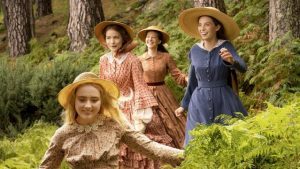
Little Women starts during the Civil War when Mr. March is away in the war as a chaplain. The family learns how to cling to one another, cling to God, and cling to hope in the midst of difficult times. This book was supposed to release December 1st and is now releasing March 1st – just when we need an anchor and a word from the Lord. I absolutely trust God’s perfect timing for this book to come out right now.
I now have books in stock, so if you’d like to order a signed book, I’d love to send one to you!! I also have bookmarks and stickers! You can order signed books HERE.
Note: If you ordered directly from Barbour Publishing, pre-orders shipped out last week. If you ordered from Amazon or another retail site, the process takes a little longer. Your books *should* be on their way this week or next. (I’m praying it’s sooner than later!)
Grace and peace,
Rachel xx
The post The Little Women Devotional is Here! appeared first on Rachel Dodge.
February 23, 2022
The Little Women Devotional is Here!

The books are here!! My new book The Little Women Devotional: A Chapter-by-Chapter Companion to Louisa May Alcott’s Beloved Classic is now available!! You can order signed copies HERE.
This book has a devotional entry for every chapter of Little Women by Louisa May Alcott. You can read a chapter of Little Women and then read the corresponding devotional entry, going through the book one chapter at a time. It is my prayer that God will use this book to speak to your heart in a personal way as you journey along with the March family.
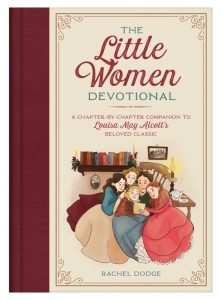 Devotional Inspiration from the March Family
Devotional Inspiration from the March FamilyThe Little Women Devotional offers lovely inspiration that explores the themes of faith, family, contentment, wisdom, and joy in the classic Louisa May Alcott novel, cherished by generations of readers.
Each reading corresponds with a chapter from the book and invites you to embrace God’s guiding hand in your life as His cherished daughter. This beautiful 48-day devotional includes original artwork throughout, and each reading includes examples from the novel, scripture, life application, and prayers that are perfect for groups, book clubs, or personal reflection.
Do you love the cover artwork? I sure do! The cover art and illustrations by Miriam Serafin are absolutely lovely. I’ll be sharing sneak peeks of the interior over the next few weeks.
Please share this with all your bookish friends!
Note: For those who want signed copies, I have signed book plates available in my shop. I hope to also have signed books in my shop in the next few weeks. Join my Subscribers List for updates.
Grace and peace,
Rachel
“Now, my little pilgrims, suppose you begin again, not in play, but in earnest, and see how far on you can get before Father comes home.” —Marmee March
Order Copies Here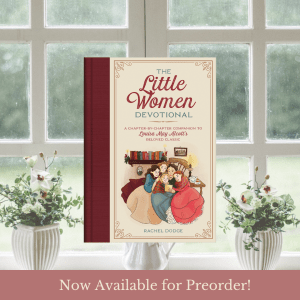 From Barbour Publishing
From Barbour Publishing
Order your copy today!



 Delivers Worldwide to over
Delivers Worldwide to over160 countries

 Order Bookmarks, Stickers, and Signed Bookplates Here ($1.00)
Order Bookmarks, Stickers, and Signed Bookplates Here ($1.00)
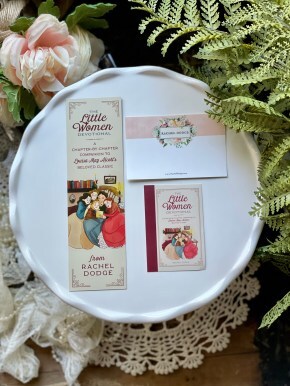
The post The Little Women Devotional is Here! appeared first on Rachel Dodge.
February 15, 2022
Northanger Abbey’s “Horrid Novels”
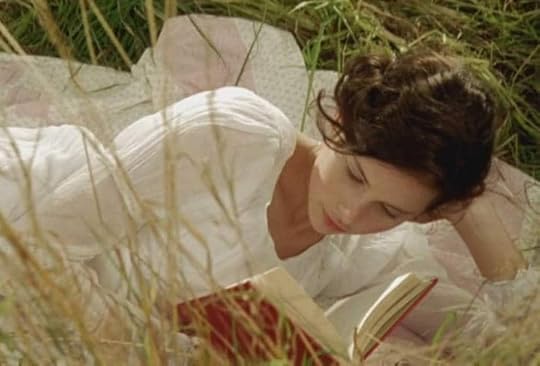
In Austen’s youth, sentimental romances and sensational Gothic novels full of dramatized heroines, dark towers and dungeons, and dangerous male villains became popular. These included novels like Charlotte Smith’s Emmeline (1788), which some believe is echoed in Austen’s early writings, and Ann Radcliffe’s The Mysteries of Udolpho (1794), which Austen later referenced in Northanger Abbey in its famous discussion of novels.
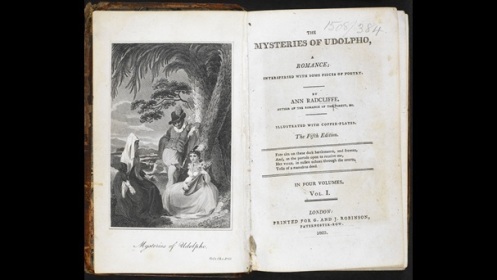 The Mysteries of Udolpho (1794) by Ann Radcliffe. Image: British Library.
The Mysteries of Udolpho (1794) by Ann Radcliffe. Image: British Library.These sensationalized novels were widely scorned by polite society and considered indecent because they were thought to promote sinful thoughts and immoral behavior. Lord Francis Jeffrey is quoted as saying the following about British fiction during the mid to late eighteenth century:
A greater mass of trash and rubbish never disgraced the press of any country than the ordinary novels that filled and supported the circulating library down nearly to the time of Miss Edgeworth’s first appearance… There had been Miss Burney’s Evelina and Cecilia…But the staple of our novel market was beyond imagination despicable, and had consequently sunk and degraded the whole department of literature of which it had usurped the name.
-Lord Francis Jeffrey, Essays, 1853.
Indeed, much of the British literary world agreed. Samuel Johnson commented on the moral obligation of fiction writers to instruct the minds of young readers: “These books are written chiefly to the young, the ignorant, and the idle, to whom they serve as lectures of conduct, and introductions into life” (Johnson, Rambler No. 4).
Are They All Horrid?So just what were these novels – this “greater mass of trash and rubbish” – that were so degrading to the public? In Northanger Abbey, Isabella Thorpe—a character we quickly learn is not the best guide or role model for any young person—lists them right out for us!
Isabella: “Dear creature! how much I am obliged to you; and when you have finished Udolpho, we will read The Italian together; and I have made out a list of ten or twelve more of the same kind for you.”
Catherine: “Have you, indeed! How glad I am! — What are they all?”
Isabella: “I will read you their names directly; here they are, in my pocket-book. Castle of Wolfenbach, Clermont, Mysterious Warnings, Necromancer of the Black Forest, Midnight Bell, Orphan of the Rhine, and Horrid Mysteries. Those will last us some time.”
Catherine: “Yes, pretty well; but are they all horrid, are you sure they are all horrid?”
Isabella: “Yes, quite sure; for a particular friend of mine, a Miss Andrews, a sweet girl, one of the sweetest creatures in the world, has read every one of them.”
Northanger Abbey, Jane Austen
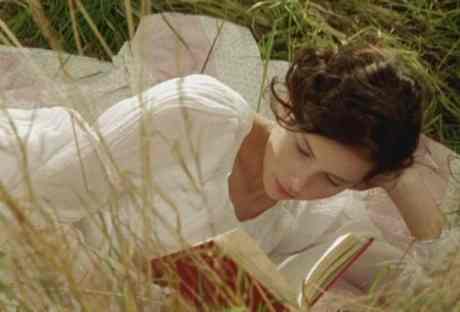 Catherine Morland (Felicity Jones), Northanger Abbey, 2007.
Catherine Morland (Felicity Jones), Northanger Abbey, 2007.Yes, that’s right. Austen gives us, her readers, the exact names of these “horrid” novels that we should definitely read avoid. But what exactly made the books on Isabella’s must-read list so deliciously “horrid”? Let’s find out!
Each of these books is now widely available online as e-texts, on e-readers, and even in print. Thanks to publishers such as Valencourt Books, we have access to these “scandalous” novels, giving them—and their genre—a proper place in the literary canon (and allowing us to more fully understand Austen’s work on Northanger Abbey).
The Castle of Wolfenbach (1793) by Eliza ParsonsThe Castle of Wolfenbach by Eliza Parsons (1793) is the novel that has been printed and reprinted the most, as it is now considered an important literary work from Austen’s day and a “highly readable” Gothic novel of its time.

No longer to be regarded as a footnote to the literary history of Jane Austen’s Northanger septet, Eliza Parsons’s Castle of Wolfenbach (1793) now secures its proper place as both a work of historical importance and a highly readable Gothic novel in its own right with this fine edition. Diane Long Hoeveler’s thoughtful introduction opens new perspectives on Parsons’s achievement in the field of what might be called “international” Gothic in her creation of an “ideologically bifurcated female Gothic, part liberal and part conservative” in its political outlook. This new edition both supplants earlier editions of this pivotal Gothic and tells us much about how the Gothic novel evolved in the late 1790s as an historical reflector of the fears, beliefs, and prejudices of a revolutionary, yet reactionary, era.
-Frederick S. Frank, Professor Emeritus of English, Allegheny College, and author of The First Gothics, Valancourtbooks.com
Book Description: Matilda Weimar flees her lecherous and incestuous uncle and seeks refuge in the ancient Castle of Wolfenbach. Among the castle’s abandoned chambers, Matilda will discover the horrifying mystery of the missing Countess of Wolfenbach. But when her uncle tracks her down, can she escape his despicable intentions?
 A sampling of covers for The Castle of Wolfenbach.
A sampling of covers for The Castle of Wolfenbach.One of the seven “horrid novels” named in Jane Austen’s Northanger Abbey, The Castle of Wolfenbach is perhaps the most important of the early Gothic novels, predating both The Mysteries of Udolpho and The Monk.
Clermont (1798) by Regina Maria Roche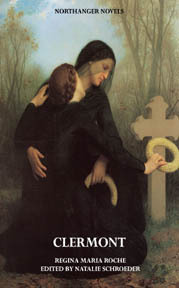
Book Description: Clermont is the story of Madeline, a porcelain doll of a Gothic heroine, who lives in seclusion from society with her father, Clermont, whose past is shrouded in mystery. One stormy night, their solitude is interrupted by a benighted traveller, a Countess who turns out to be a friend from Clermont’s past.
Madeline goes to live with the Countess to receive her education, but her new idyllic life soon turns into a shocking nightmare. Ruffians attack the gentle Countess, and Madeline is assaulted in a gloomy crypt. And to make matters worse, a sinister stranger appears, threatening to reveal the bloody truth of Clermont’s past unless Madeline marries him. Can she avoid the snares of her wily pursuers, solve the mystery of her father’s past, and win the love of her dear De Sevignie?
Book Description: The good old Count Renaud is dead, and his will makes the degenerate Rhodophil his heir, disinheriting his other son Ferdinand, who has married against his father’s wishes. Rhodophil promises to share his new riches with his younger brother and his wife Claudina, but Ferdinand hears a mysterious voice from beyond the grave, warning him to flee his brother and his wife to save himself from sin and death!
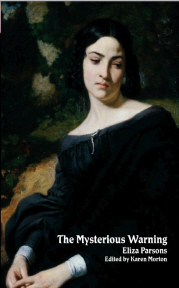
Ferdinand obeys the supernatural warning and sets out to find fortune and adventure. In the course of his quest he will encounter a recluse in a ruined castle with a horrible secret, find himself captured and imprisoned by the Turkish army, and encounter one of Gothic literature’s most depraved female characters, the monstrous Fatima. And if he survives all these dangers, Ferdinand must return to Renaud Castle to solve the mystery of the ghostly voice and uncover the terrible truth about his wife and his brother!
The Necromancer; or, The Tale of the Black Forest (1794) by Lawrence FlammenbergBook Description: “The hurricane was howling, the hailstones beating against windows, the hoarse croaking of the raven bidding adieu to autumn, and the weather-cock’s dismal creaking joined with the mournful dirge of the solitary owl…”
The Necromancer consists of a series of interconnected stories, all centering on the enigmatic figure of Volkert the Necromancer. Filled with murder, ghosts, and dark magic, and featuring a delirious and dizzying plot that almost defies comprehension, The Necromancer is one of the strangest horror novels ever written.
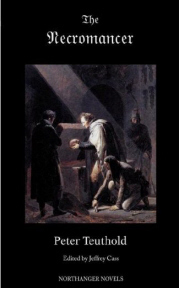
One of the earliest Gothic bestsellers, The Necromancer was first published in 1794, and after more than two centuries still retains the power to thrill and fascinate readers.
The Orphan of the Rhine (1798) by Eleanor SleathBook Description: Seduced and betrayed by a rake, Julie de Rubine lives in seclusion with her infant son, Enrîco. One day, their calm retirement is interrupted by the Marchese de Montferrat, who promises to provide for Julie and her son if she agrees to care for an unfortunate orphan, Laurette, whose origin is shrouded in mystery. Under the assumed name of Madame Chamont, Julie raises the two children, whose youthful friendship eventually blossoms into love.
As Laurette matures, she resolves to learn the identity of her real parents. Her only clues are a painted miniature of a beautiful lady and the whisperings of a sinister monk, who warns her to avoid the Marchese de Montferrat. But when Julie is kidnapped by banditti and Laurette is taken to the gloomy castle of the lascivious Marchese, will she be able to uncover the truth and marry her beloved Enrîco, or will she fall victim to the lustful Montferrat?
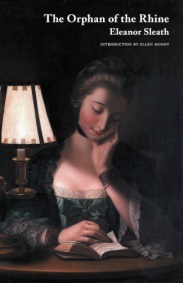
The rarest of the seven “horrid novels,” Eleanor Sleath’s The Orphan of the Rhine (1798) is indebted to Ann Radcliffe’s The Mysteries of Udolpho (1794) and Regina Maria Roche’s The Children of the Abbey (1796) but possesses a charm and fascination all its own.
Horrid Mysteries (1796) by Carl GrosseBook description: A bizarre work whose labyrinthine plot defies summary, Horrid Mysteries (1796) recounts the experiences of Don Carlos and his friend, the Marquis of G******, who become entangled in the web of a secret society bent on world domination. As the heroes flee from place to place across Europe, the agents of this dark confederacy, seemingly possessed of supernatural powers, are always at their heels—and death lies around every corner!
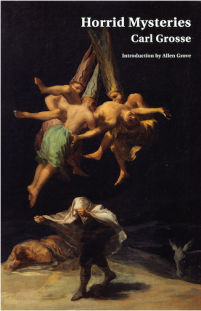
Unavailable for nearly 50 years, this unabashedly lurid Gothic novel written by an enigmatic German who styled himself the “Marquis of Grosse” and “Marquis of Pharnusia” returns to print at last as the seventh and final reissue in Valancourt’s series of the rare Gothic novels mentioned in Jane Austen’s Northanger Abbey.
Gothic Novels and Jane AustenFor more on this topic, our own Tony Grant has also written about Austen’s influences and her work on Northanger Abbey in his article, Netley Abbey and the Gothic. In his article, Tony also references an article by John Mullan on the fascinating topic of Gothic literature that is well worth your time: The Origins of the Gothic.
In his Rambler No. 4, Johnson said that the “task” of “present writers” is to write books that “serve as lectures of conduct, and introductions into life” so that “nothing indecent” should be set in front of the eyes of young men and women.
As sensational, Gothic novels were being written, other authors were at the same time attempting to raise the bar and write novels that were both entertaining and instructive. Many of the books in each of these genres are novels with which Austen herself was familiar or, in many cases, would have read. Next month, I’ll be talking about didactic fiction—writing that was meant to provide positive role models and good morals—and the influence it had on Austen’s writing.
The post Northanger Abbey’s “Horrid Novels” appeared first on Rachel Dodge.
February 10, 2022
The Little Women Devotional – Coming March 1st!

My new book The Little Women Devotional: A Chapter-by-Chapter Companion to Louisa May Alcott’s Beloved Classic is releasing on March 1st!! You can order copies HERE.
This book has a devotional entry for every chapter of Little Women by Louisa May Alcott. You can read a chapter of Little Women and then read the corresponding devotional entry, going through the book one chapter at a time. It is my prayer that God will use this book to speak to your heart in a personal way as you journey along with the March family.
 Devotional Inspiration from the March Family
Devotional Inspiration from the March FamilyThe Little Women Devotional offers lovely inspiration that explores the themes of faith, family, contentment, wisdom, and joy in the classic Louisa May Alcott novel, cherished by generations of readers.
Each reading corresponds with a chapter from the book and invites you to embrace God’s guiding hand in your life as His cherished daughter. This beautiful 48-day devotional includes original artwork throughout, and each reading includes examples from the novel, scripture, life application, and prayers that are perfect for groups, book clubs, or personal reflection.
Do you love the cover artwork? I sure do! The cover art and illustrations by Miriam Serafin are absolutely lovely. I’ll be sharing sneak peeks of the interior over the next few weeks.
Please share this with all your bookish friends!
Note: For those who want signed copies, I have signed book plates available in my shop. I hope to also have signed books in my shop in the next few weeks. Join my Subscribers List for updates.
Grace and peace,
Rachel
“Now, my little pilgrims, suppose you begin again, not in play, but in earnest, and see how far on you can get before Father comes home.” —Marmee March
Pre-Order Here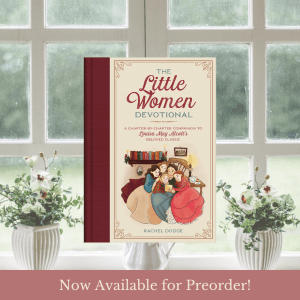 March 1st
March 1st
from Barbour Books


 Delivers Worldwide to over
Delivers Worldwide to over160 countries

 Order Bookmarks, Stickers, and Signed Bookplates Here ($1.00)
Order Bookmarks, Stickers, and Signed Bookplates Here ($1.00)

The post The Little Women Devotional – Coming March 1st! appeared first on Rachel Dodge.
January 24, 2022
The Little Women Cookbook
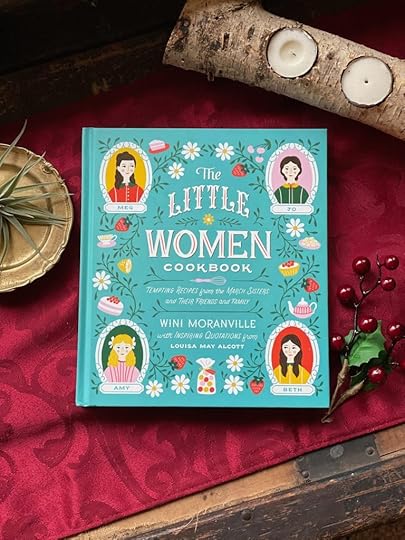
I really love exploring literary cookbooks, and when it comes to Little Women, there are a few to choose from! Recently, I purchased The Little Women Cookbook: Tempting Recipes from the March Sisters and Their Friends and Family, and I’ve enjoyed it very much!
For me, these books are more about reading than cooking, but I do have a few recipes I’d love to try!! But the thing I really love about this particular cookbook is the quotes and snippets from the novel that tie in with each recipe. You can tell that the author really took the time and creativity to create recipes that Little Women lovers would enjoy.
 Book Description:
Book Description:Experience the exciting and heartwarming world of the March sisters and Little Women right in your own kitchen.
This cookbook celebrates the scrumptious and comforting foods that play a prominent role in Louisa May Alcott’s classic novel Little Women. If your family includes a Little Women fan, or if you yourself are one, with this book you can keep the magic and wonder of the beloved tale alive for years to come. Do you wonder what makes the characters so excited to make—and eat!—sweets and desserts like the exotically named Blancmange or the mysterious Bonbons with Mottoes, along with favorites like Apple Turnovers, Plum Pudding, and Gingerbread Cake? Find out for yourself with over 50 easy-to-make recipes for these delectable treats and more, all updated for the modern kitchen.
From Hannah’s Pounded Potatoes to Amy’s Picnic Lemonade, from the charming Chocolate Drop Cookies that Professor Bhaer always offers to Meg’s twins to hearty dinners that Hannah and Marmee encourage the March sisters to learn to make, you’ll find an abundance of delicious teatime drinks and snacks, plus breakfasts, brunches, lunches, suppers, and desserts.
Featuring full-color photos, evocative illustrations, fun and uplifting quotes from the novel, and anecdotes about Louisa May Alcott, this is a book that any Little Women fan will love to have.
Here are a few samples from the interior of the book to give you a glimpse of the headings and contents (and the beautiful photography) throughout this cookbook!

 Bookish Foodies
Bookish FoodiesIf you love Little Women or you love to cook – or even if you just like to look at pretty photos of food – I think you’ll enjoy this book! It would also make a great gift for any literature lover/foodie in your life.
If you already own this book and have made any of the recipes, please tell us about your favorites in the comments. I need to go roll up my sleeves and get cooking!
Grace and peace,
Rachel
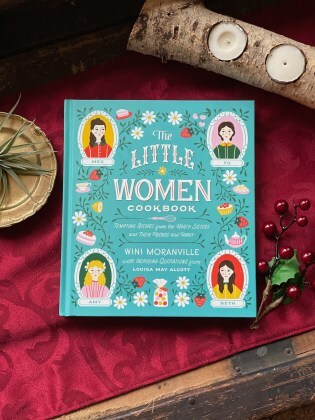 About the Author
About the AuthorWini Moranville is the author of the upcoming cookbook, Everyday French Cooking: Modern French Cuisine Made Simple (Harvard Common Press, April 2022). She is also the author of The Bonne Femme Cookbook: Simple, Splendid Food That French Women Cook Every Day and The Little Women Cookbook.
In addition to being a cookbook author, Wini has worked as a restaurant critic, editor, and feature writer on countless cookbooks and food magazines and websites, from Better Homes and Gardens to Bonjour Paris. You can visit her online at www.winimoranville.com.

The post The Little Women Cookbook appeared first on Rachel Dodge.



